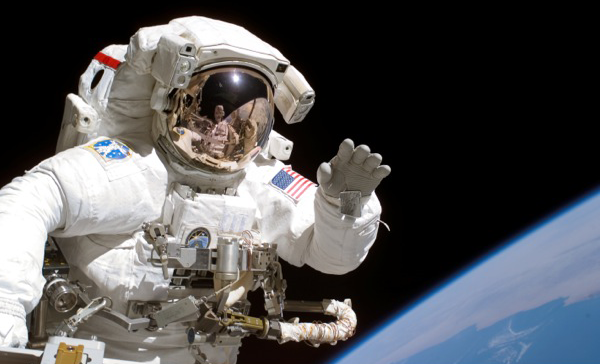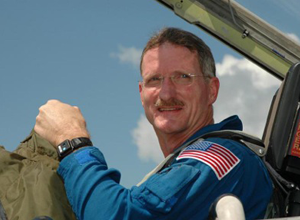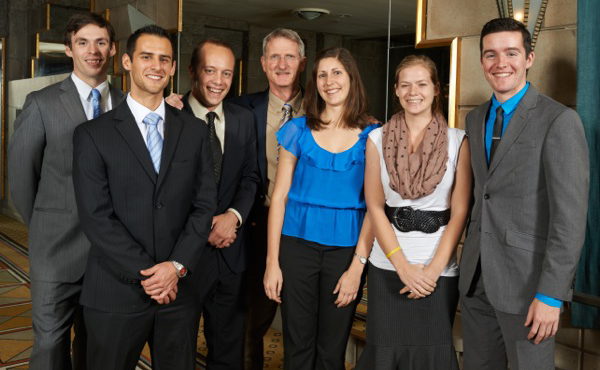Five questions for Joseph Tanner
Tanner on an EVA, or extra-vehicular activity, more commonly referred to as a spacewalk. Home page photo: In this favorite souvenir of Tanner’s, he is silhouetted with the Earth, sun and the Hubble Space Telescope.
Joe Tanner grew up in the ‘60s when “nearly everyone was enamored with the space race and would have loved to have been on one of those rockets with the heroes who were doing that.” At the time, Tanner didn’t think he could be a “superhero,” as the media referred to them, but the seed had been planted.
Tanner studied mechanical engineering at the University of Illinois, and just before he graduated, he found himself looking at recruiting posters for the Navy. His father had gotten him interested in flying, and he would borrow his father’s airplane so that he could log enough hours to earn his pilot’s license. At the same time, he began interviewing for engineering jobs.
“I decided I would be an engineer later and go fly airplanes” instead, Tanner said. “I got my pilot’s license the day before I joined the military at age 23 and a half. I got my license on a Sunday and shipped out with the Navy on Monday.”
A Navy squadron mate was one of the 35 original astronauts selected for the space shuttle program. As the pair talked about the program, Tanner decided to do everything he could to become an astronaut.
After 11 year as a Navy pilot, he became a NASA pilot in 1984. Then in 1992, he realized his goal of becoming an astronaut and over the years, was chosen for four space shuttle flights. In 2008, he retired from NASA and began looking for other opportunities. He had always loved the college environment and applied for a position at the University of Colorado-Boulder. He and his wife owned property near Telluride and planned to retire there someday, so working for the university has been the perfect transition from government life to pre-retirement. Tanner is a senior instructor in aerospace engineering sciences and directs a graduate and Ph.D. student project course.
1. You began working for NASA as a pilot. What was one of your favorite memories from that job?
I was an aerospace engineer and research pilot, and while we did some research projects on aircraft improvements, mostly I was an instructor for astronauts and other pilots. One of my favorite parts of the job was flying the shuttle training aircraft – a modified Gulfstream II that was a near perfect airborne simulator for the last 30,000 feet of the shuttle’s descent and landing. I spent seven years instructing astronaut pilots how to land the shuttle. When I became a shuttle crew member, I actually had more training looks at landing the shuttle than the two pilots did.
I’ll always remember a certain shuttle commander who had just finished the last training flight he would have before launching the next day. The training session was over and we were sitting in the airplane. He was getting ready to get out and I had just shut the engines down. He shook my hand and said, “Joe, thanks for helping me, preparing me to land the Space Shuttle.” That was really nice to have him say it. There was also nothing like joining up with the shuttle when it was descending to the Earth, at 20,000 feet, and flying down with it.
2. You were a Mission Specialist for four shuttle flights. What was your role on each of the flights and how did you feel when the shuttles were retired?
The first mission (aboard Atlantis) studied the atmosphere around Earth. We were looking at the chemical composition of the middle atmosphere, and also looking at the ozone hole and following it as it broke up in the late Antarctic winter. We studied the energy from the sun, and energy absorbed by our atmosphere. It was the perfect first mission because I got a chance to look out the window and enjoy the view -- and realize where I really was -- without the burden of a packed schedule.
The other three missions were really packed with activities, including extra-vehicular activity (EVA), or spacewalking, as the media calls it. We didn’t have much of a chance to look out the window to ponder Earth as it went by.
On the second mission (Discovery), we went to the Hubble Space Telescope and made repairs and upgrades. The third and fourth missions were for the International Space Station. We brought up modules for and installed electrical power on the space station.
The second flight included my first EVA. They didn’t let everyone touch the Hubble Space Telescope -- only 14 or so people in the world who have done it, and I got to be one of those. It was a double treat, my first EVA and the Hubble. It was hard work, stressful because you didn’t want to make mistakes. The labor is physical and hard on your hands and tiring, but it’s a good kind of tired.
My third mission (Endeavour) was my first to the Space Station, and our crew was the first to join up with the station while there were people inside. We were able to open the hatches and see where they lived and spend some time with them. They were filming an IMAX movie, “Space Station,” and I got to film three of the scenes. I’m actually in one of them. It wasn’t a very prominent role, however, but it was really cool.
On my last mission (Atlantis), we were the first to restart the assembly of the Space Station after the Columbia accident. We had lots of “firsts,” which makes it interesting for the crew.
People ask me which mission is my favorite; right now I like the third. Maybe it’s because I just finished celebrating my 13-year anniversary of it. I semi-celebrate each mission as it comes and goes over the months. This one launched on the 30th of November and landed on Dec. 10.
I miss a lot, but not everything about NASA. I definitely miss the people and the aircraft. I absolutely miss space flying, but you can’t do that forever. I was sad to see the shuttle go. It was like an old friend. I’m a huge shuttle fan. I don’t think we’ll have in my lifetime a space vehicle as capable as the shuttle was the day it last flew. But it had two major design flaws that couldn’t be reconciled with the amount of money we would want to put into it. The flaws had been there from Day One and we really couldn’t do anything about them.
3. What are your responsibilities at CU and what do you hope your students take from your lectures/classes?
I coordinate and teach a course called Graduate Projects in Aerospace Engineering. It’s a hands-on course for master’s and Ph.D. candidates in the aerospace department, but we also encourage students from the electrical engineering, computer science and mechanical engineering departments to join us. It’s a great way to teach interdisciplinary teamwork. The two-semester course is a pathway to graduation rather than doing a thesis for aerospace engineering sciences students. The projects we do are quite sophisticated, and one, which took years to complete – about 65 students worked on it – is a satellite that is still in orbit producing data. The overall goal of the course is to teach grad students about the design process, how to work in teams of eight or so people, and how to coordinate their efforts with the constraints of budgets, schedules, and design reviews. It’s all the things they will do when they get out into the industry. The feedback we get is that the program is very successful.
The reason I’m here is for the students. They often ask me why I came here and I say, “I came for you.” I feel like it’s a privilege for me to get a chance to give back some of what I have been given. I wasn’t a particularly good student or a dedicated student. I focused more on athletics than I did on my studies, but I managed to squeak by with a mechanical engineering degree. But here’s my chance to come back and pass on some of the lessons I’ve learned to the generation I hope will lead us into the future, not only in space exploration, but in general as members of this world community. There are a lot of students here who would love to have the career path I did. If I can do anything to help them along, then I’m more than willing to do it and I take great pleasure in it.
4. What are some hobbies or activities you enjoy outside of work?
Well, I just finished building a house on that property near Telluride. It’s where my wife and I will spend Christmas this year. I had a building contractor, but they allowed me to be part of the crew. I had worked construction in 1980 when my wife and I had just gotten married and we lived in Summit County for a few years. But this time I was able to participate in the design process for a house and then take it from the first shovelful of dirt to the final inspection. Most of the work was done in the summer, so I was there every day with my tool belt on – I have the scars to prove it. It was just a blast. In my leisure time, when I find some, I love being in nature, hiking, camping. Like everyone else here, I enjoy skiing and I climb a few mountains now and again. I have grandchildren now and definitely enjoy being with them. I love my two sons and cherish the chances I get to be with them.
I also enjoy working on my two vintage cars – a 1971 Datsun 240Z that I actually drive to school on good weather days, and a 1973 Chevy Corvette. And my son and I rebuilt a 1969 Camaro as a father/son project, but that’s his car.
5. Do you have a favorite item or memento in your office?
I have several. First are the pictures of my wife and kids, which are way more important than anything else. I have in a place of real prominence the pilot wings I was awarded in 1973 when I finished naval flight school. Those are framed. My dad pinned them on me, so that makes them doubly important.
I didn’t know it at the time, but a good friend of mine -- a civilian swim coach who I helped by swimming with the team (I had been a collegiate athlete) -- managed to get that pair of wings and have them engraved on the back and then gave them to the Navy to give to me.
Right above that in another position of honor is a picture that Greg Harbaugh took of me on my second mission with the Hubble Space Telescope and the Earth and Sun in the background. It’s quite the popular picture. There’s a gift given to me by the workers at Kennedy Space Center. I spent three-and-a-half years working down there as a member of the crew that would strap the astronauts into the Space Shuttle. We were also the first to come into vehicle after it landed and get them out. It was a great job and we all loved doing it.
I had all this stuff from NASA just sitting in boxes. I didn’t want to populate the house with an “I love me wall;” I didn’t want to do that to my wife, so we have almost nothing related to space in our house. It’s all here in my office.





